NCERT Solution of Class 8 Science Important Question Answer solution with pdf. Here We Provides Class 1 to 12 all Subjects NCERT Solution with Notes, Question Answer, CBSE and HBSE Important Questions, MCQ and old Question Papers for Students.
- Also Read :- Class 8 Science NCERT Solution
- Also Read :- Class 8 विज्ञान NCERT Solution
CBSE and HBSE Solution of Class 8 Science important Question And Answer solution.
CBSE Class 8 Science Important Question Answer for 2023-24
Chapter 1 – Crop Production and Management Important Questions
Q.1 What are Kharif Crops? ( Most Important )
Ans – The Crops which are grown in Rainy Season between June to September are called Kharif crops. Examples-Maize, Soyabean, Cotton, Groundnut
Q.2 What are Rabi Crops? ( Most Important )
Ans – The Crops which are grown in winter Season between October to March are called Rabi Crops. Example- Wheat, gram, pea, mustard
Q.3 What are the Basic Practices of Crop Production?
Ans – There are some basic agricultural activities that are used in crop production.
- Preparation of soil
- Sowing
- Adding manures and fertilisers
- Irrigation
- Protecting from weeds
- Harvesting
- Storage of Grains
Q.4 What is Ploughing?
Ans – The Process of Loosening and turning of soil is called tilling or ploughing. This is done by a Plough made up of wood or Iron.
Q.5 Differentiate between Fertilisers and Manure. ( Most Important )
Ans – Fertilisers is a man-made inorganic salt that is prepared in factories. These chemicals are rich in Nitrogen, Phosphorous, and potassium.
Manure is a natural organic substance of cattle dunk that is prepared in fields. Manures are less rich in plant nutrients.
Q.6 Name any two modern methods of irrigation.
Ans – Sprinkler system and Drip system.
Q.7 What is Harvesting?
Ans – The cutting of crop after it is mature is called harvesting.
Q.8 What are weeds?
Ans – Some undesirable plants grown in the field with the crop are called weeds. The removal of these weeds is called weeding.
Q.9 What is Animal Husbandry?
Ans – Animals reared at home or on farm, have to be provided with proper food, shelter, and care on a large scale is called animal Husbandry.
Q.10 What is Threshing?
Ans – The process of separation of grains from the chaff is called threshing.
Chapter 2 – Microorganisms Friend and Foe Important Questions
Q.1 What are the Major groups of classification of microorganisms?
Ans – There are four major groups. These are Bacteria, fungi, protozoa, and algae.
Q.2 What are antibiotics?
Ans – Such kind of medicines that can kill or stop the growth of microorganisms are called antibiotics.
Q.3 What are antibodies?
Ans – When a disease-carrying microbe enters in our body then the body protects us from such diseases with making antibodies.
Q.4 What are Communicable diseases?
Ans – Microbial disease that can spread through food, water or any physical contact are called communicable diseases. Example- Common cold, chicken pox
Q.5 Name some diseases caused by the virus.
Ans – Measles, Chicken pox, polio, Hepatitis A.
Q.6 Name Some Diseases caused by Bacteria.
Ans – Tuberculosis, cholera, typhoid.
Q.7 Name some Chemical methods of Preserving food.
Ans – There are following ways to preserve food.
- Preservation by common salt
- Preservation by sugar
- Preservation by oil and Vinegar
- preservation by heat and cold process
Q.8 What is Pasteurisation? ( Most Important )
Ans – The Method of preserving food from microorganisms where food is heated and then cooled down suddenly is called pasteurisation.
Q.9 Write some Benefits of Yeast.
Ans – Yeast plays an important role in our day to day life. Here are some uses / Benefits of Yeast.
- Convert milk into curd
- Making of alcohol
- Used in the making of Bread, Pastries, and Cakes
Q.10 What is Fermentation?
Ans – The Process of Conversion of sugar into alcohol is called fermentation.
Chapter 3 – Coal and Petroleum Important Questions
Q.1 What is Natural Resources?
Ans – Those Resources that are obtained us from nature is called natural resources. Example- Coal, sunlight, petroleum, minerals and much more.
Q.2 What is Inexhaustible Natural Resources?
Ans – These resources are present in unlimited quantity and never ends is called inexhaustible natural resources. Example- Sunlight, air
Q.3 What is Exhaustible Natural Resources?
Ans – These resources are present in limited quantity and end with usage is called exhaustible natural resources. Example- Coal, Petroleum
Q.4 What is Fossil Fuels?
Ans – This type of fuel is obtained from the death of living organisms. such organisms take crore of years to convert them into fuel. This fuel is called fossil fuels. Example- Coal, Petroleum, Natural Gas.
Q.5 What Materials are obtained us after Burning of Coal?
Ans – We obtain Coke, Coal tar, and coal gas with a large amount of heat.
Q.6 What is Petroleum Refinery?
Ans – The Place where the Components of Petroleum are separates out are known as petroleum refinery.
Q.7 Why Coke is important Product of Coal? ( Most Important )
Ans – Coke is a tough, porous and black substance. It is used in the manufacturing of steel and in the Extraction of many metals.
Q.8 What is the Use of CNG?
Ans – CNG Stands for Compressed Natural Gas. CNG is used in vehicles as a fuel. This fuel is free from Environment pollution, so it is best for use.
Q.9 What products are obtained after the Refining of Petroleum?
Ans – After Refining of petroleum LPG, Petrol, Diesel, Kerosene, Lubricant oil, Paraffin Wax and Bitumen is obtained in high amount.
Q.10 Natural gas is found in which part of the country?
Ans – Natural gas is found in the Tripura, Rajasthan, Maharastra and Krishna Godawari delta.
Chapter 4 – Combustion and Flame Important Questions
Q.1 What is Combustion?
Ans – A chemical process in which a substance reacts with oxygen to give off heat is called combustion.
Q.2 What is Fuel?
Ans – The Substance that undergoes combustion is known as fuel.
Q.3 What is Ignition Temperature?
Ans – The lowest temperature at which any substance catches fire is called its ignition temperature.
Q.4 What is Inflammable Substance?
Ans – The Substance that has very low ignition temperature and can easily catch fire with a flame is called inflammable substance.
Q.5 How many types of Combustion occurs?
Ans – There is mainly three types of combustion.
- Rapid Combustion
- Spontaneous combustion
- Explosion
Q.6 Describe the Structure of Candle flame. OR What are the Different Zones of Candle? ( Most Important )
Ans – There are the following parts of a Candle Flame. Let’s Discuss one by one.
- Outer Zone – This is the hottest part of candle flame looks in blue colour.
- Middle Zone- This is a moderate hot part of a candle flame look in yellow colour.
- Innermost Zone– This part is the least hot part of a candle flame. It has black in colour due to carbon vapours.
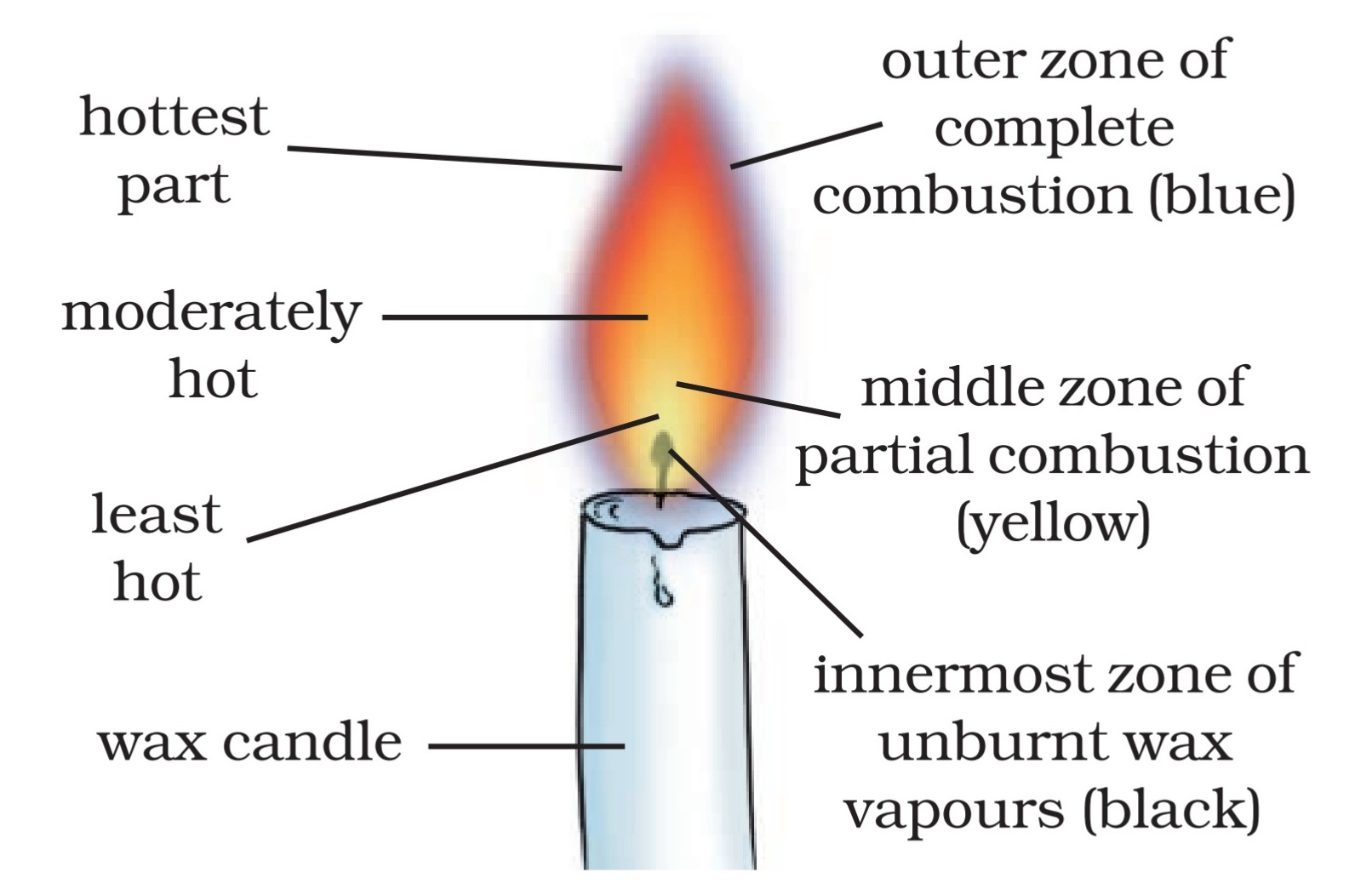
Q.7 What is acid rain? ( Most Important )
Ans – Oxides of Sulphur and nitrogen dissolve in rain water and forms acid. This acid falls on the earth surface as acid rain.
Q.8 What is Fuel Efficiency?
Ans – The total amount of energy produced by one Kilogram of Fuel is known as fuel Efficiency. Unit of Fuel Efficiency is KJ / Kg.
Q.9 How carbon dioxide is able to stop fires? ( Most Important )
Ans – Carbon Dioxide is Heavy gas than oxygen so it makes a layer around substance and cuts off the supply of oxygen. Without oxygen fire is Impossible.
Q.10 Which Zone of the flame is used by Goldsmith for melting gold and silver?
Ans – Outermost Zone of Flame is used by goldsmith because the blue coloured outer zone is the hottest part of the flame. With this high-temperature gold and silver can be easily melted.
Chapter 5 – Conservation of Plants and Animals Important Questions
Q.1 What is deforestation?
Ans – Deforestation means clearing of forests and uses that land for any other purposes like making buildings, factories.
Q.2 What is Desertification?
Ans – The soil has less humous and less fertile due to lack of water in some regions. Such fertile land converted after drought into deserts. It is called desertification.
Q.3 What are Biosphere Reserves? ( Most Important )
Ans – Biosphere reserves are the area reserved for the conservation of biodiversity. Example- Pachmarhi Biosphere Reserve
Q.4 What is Wildlife Sanctuaries?
Ans – These places are prohibited for capturing animals. These areas Provide Suitable living conditions to wild animals.
Q.5 What is National park?
Ans – National park is an area where endangered animals are kept for protection.
Q.6 What is Endangered Species?
Ans – Those Species that can face the problem of extinction are known as endangered species. Example- wild Buffalo, tiger, Barasingha.
Q.7 What is Ecosystem?
Ans – An Ecosystem is made up of all species of plants, animals and microorganisms with including non-living things.
Q.8 What is Biodiversity? ( Most Important )
Ans – Biodiversity means various species of plants and animals in particular areas.
Q.9 What is Flora and Fauna?
Ans – Flora word is used for the Plants and Fauna word is used for animal all species.
Q.10 What are Endemic Species?
Ans – Endemic Species are those species of plants and animals that are found in a particular area. Such species are endemic to a Zone. Example- Wild Mango, Giant Squirrel.
Q.11 What is Red Data Book?
Ans – Red data book is the source book that keeps a record of all endangered animals and plants.
Q.12 Define Migration.
Ans – Migration means move from one place to another place in order for survival.
Q.13 What is Reforestation?
Ans – Reforestation is the restocking of the destroyed forest by planting new trees.
Chapter 6 – Reproduction in Animals Important Questions
Q.1 What are the mode of Reproduction?
Ans – There are two modes of reproduction.
- Sexual Reproduction
- Asexual Reproduction
Q.2 Define Sexual Reproduction.
Ans – This type of Reproduction Beginning from the fusion of male and female gametes is called sexual reproduction.
Q.3 Describe male reproductive system in humans. ( Most Important )
Ans – The male reproductive system includes a pair of testes, two sperm ducts and a penis. The testes produce the male gametes called sperms.
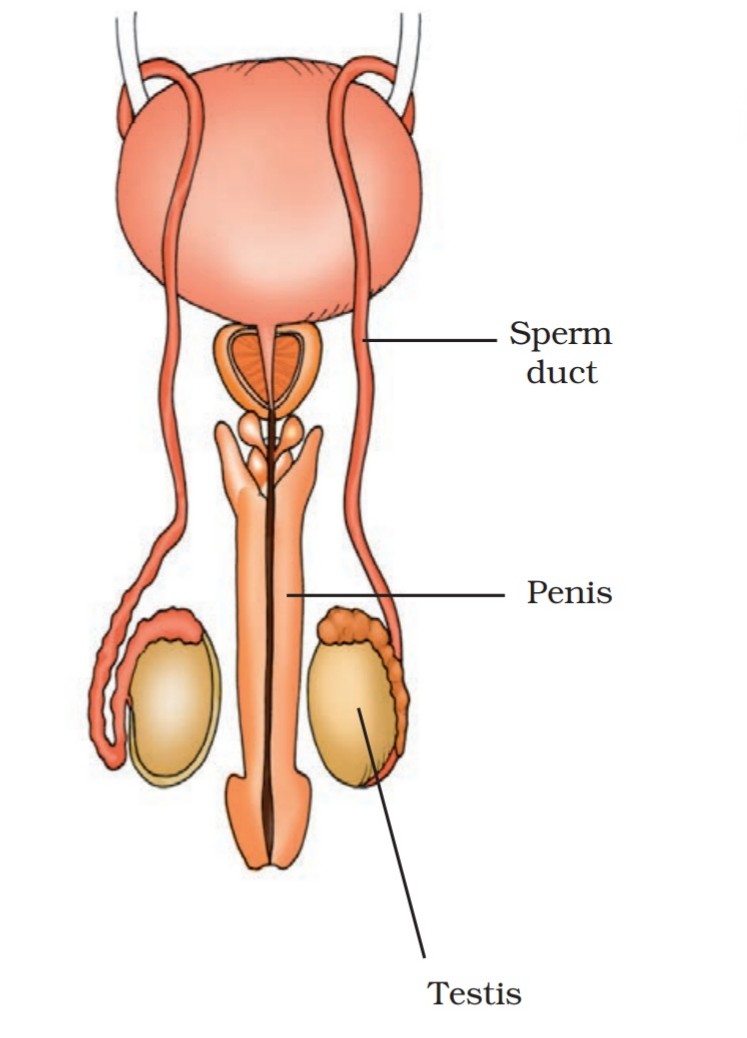
Q.4 Describe Female Reproductive System in Humans. ( Most Important )
Ans – The female reproductive system includes a pair of ovaries, oviducts and uterus. The ovary produces female gametes called ova ( egg).
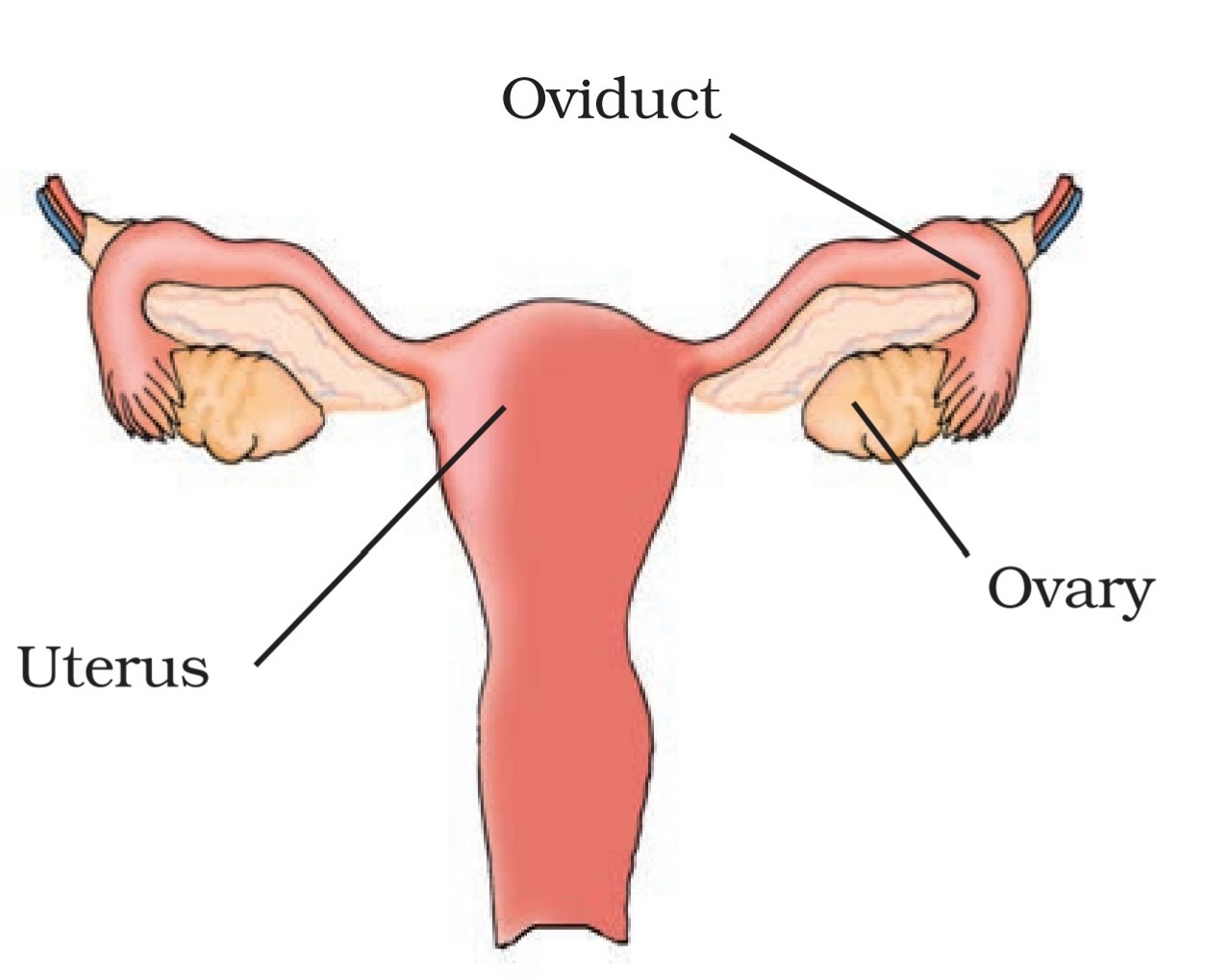
Q.5 What is Fertilisation? ( Most Important )
Ans – Fertilisation is the process of fusion of male gametes Sperm with Female gametes Ova. This Result in the formation of Zygote.
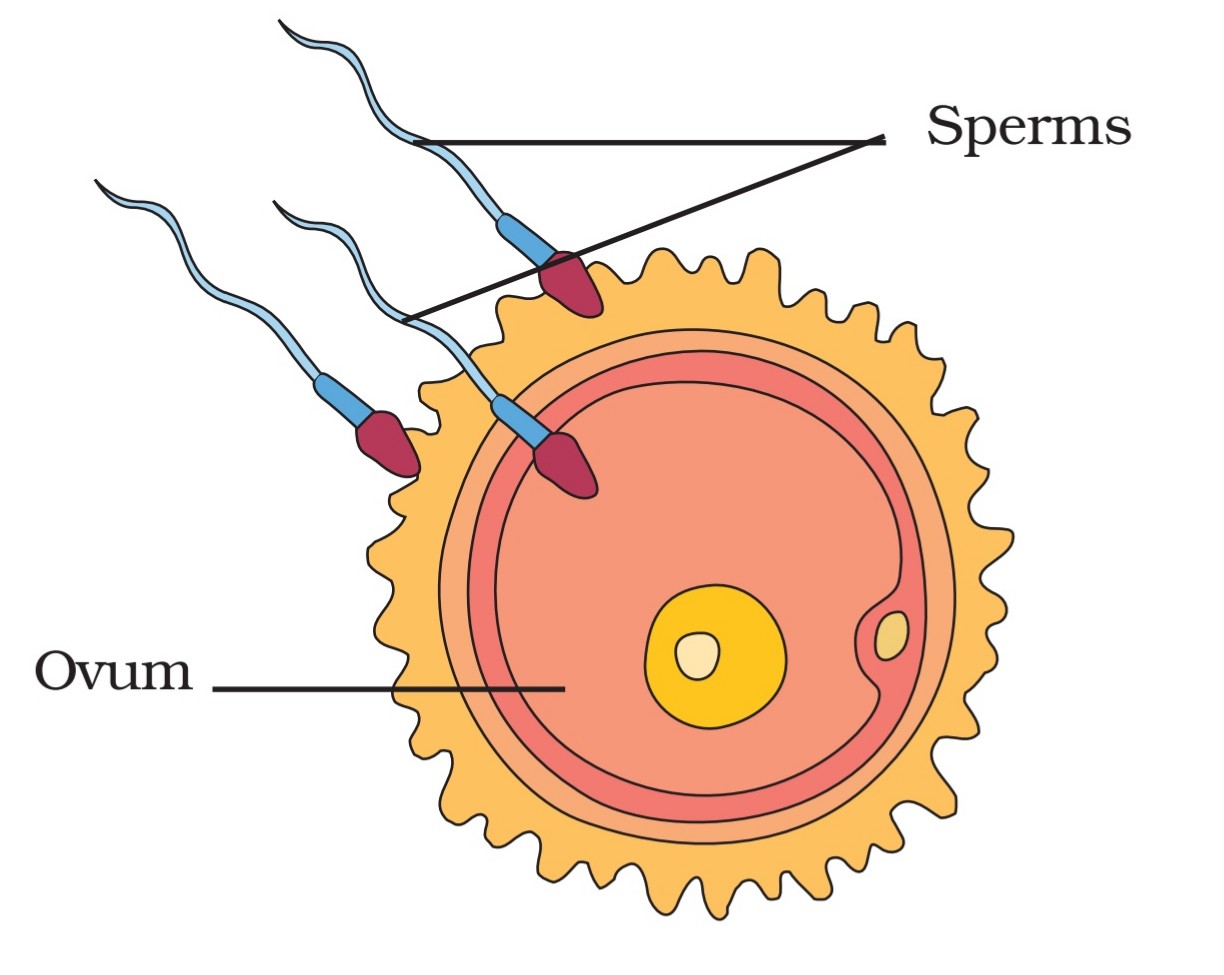
Q.6 What is External Fertilisation?
Ans – This type of fertilisation in which the fusion of a male and female gametes takes place outside the body of the female is called external fertilisation.
Q.7 What is Embryo?
Ans – After fertilisation, the cell starts converting into tissues and various part of the body. This development stage of the body is called embryo.
Q.8 What is Viviparous and Oviparous animals?
Ans – The animals that give birth to young ones are called viviparous animals. Those animals that give eggs are called oviparous animals.
Q.9 What is metamorphosis?
Ans – The Process of transformation of a larva into an adult frog is called metamorphosis.
Q.10 What is Asexual Reproduction? Give any Example.
Ans – This types of reproduction start with the division of body into two parts. Example- Budding in hydra, Binary fission in Amoeba.

Chapter 7 – Reaching the Age of Adolescence Important Questions
Q.1 What is adolescence? ( Most Important )
Ans – The period of life, when the body undergoes changes, leading to reproductive organs maturity is called adolescence.
Q.2 What is puberty?
Ans – Puberty is that time period of Life when the body develops all organs and the body parts. Puberty starts near 11 years old and ends at 18 – 19 years of age.
Q.3 What are the major changes during puberty?
Ans – There are the following major changes observed during puberty.
- Increase in height
- Change the body shape
- Voice Changes
- Development of sex organs
- Reaching mental, Intellectual and Emotional maturity
Q.4 What is Adam’s Apple? ( Most Important )
Ans – At puberty, the voice box or larynx begins to grow. The growing voice box can be seen in the throat is called Adam’s apple.
Q.5 What are hormones?
Ans – Hormones are the chemical substance that helps in the regulation of the body. There are many hormones for various purposes. Here are the image of some Major hormones that are found in our human body.
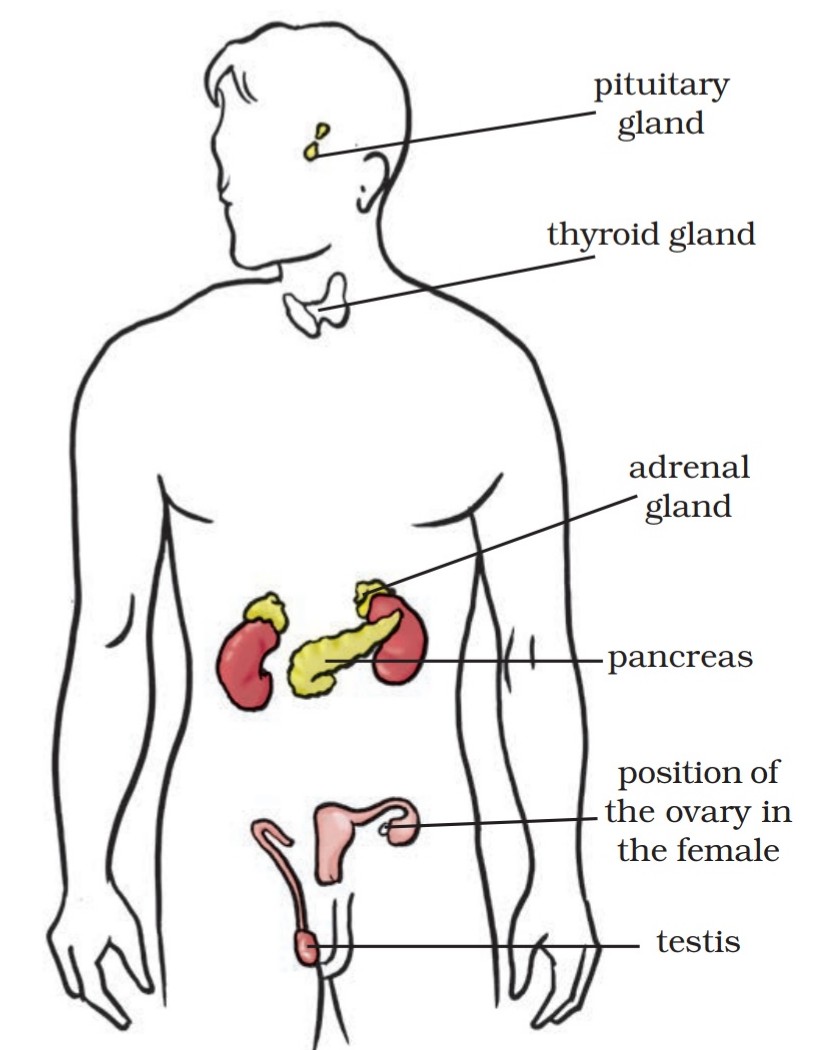
Q.6 Which hormones are used in reproduction?
Ans – Males hormone Testosterone and Female hormone estrogen is used in Reproduction.
Q.7 How is the sex of the baby Determined? ( Most Important )
Ans – There are two kinds of Chromosomes i.e. X and Y. Males have X and Y whereas females have X and X chromosomes. When Male X fertilise with female X Chromosome then the baby will be a girl. If the Male Y Chromosome fertilises with female X Chromosome then Baby is a boy. See images for better understanding.
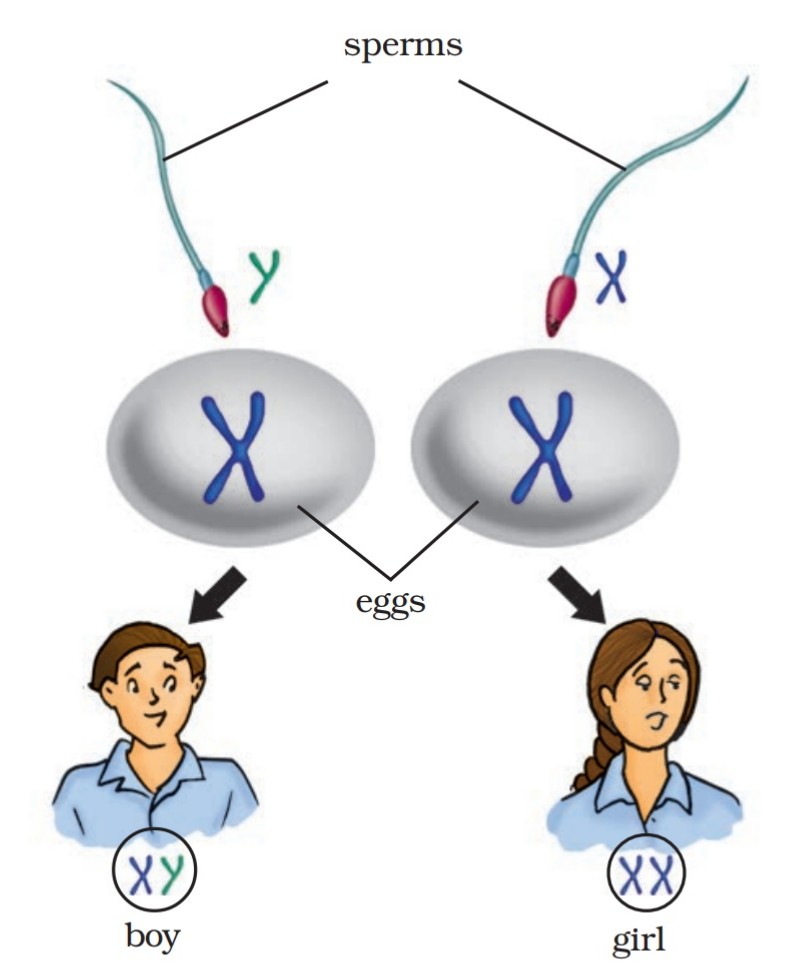
Q.8 Which hormone is responsible for growth?
Ans – Growth hormone is responsible for the growth of a child. Growth hormone is secreted by the Pituitary gland.
Q.9 What is balanced diet?
Ans – A diet that is full of all nutrients like carbohydrate, protein, fat, vitamins and minerals in a balanced form is called balanced diet.
Q.10 The development of frog is controlled by which hormone?
Ans – Thyroxine hormone helps the frog for development from larva to an adult.
Chapter 8 – Force and Pressure Important Questions
Q.1 What is Force?
Ans – A Push or Pull on an object is called force. Force is the interaction between two objects.
Q.2 What happens when force is applied on an object?
Ans – Force can Change much value of an object. let’s read one by one.
- A force can change state of motion
- Force can change the shape of an object
- Same direction force added with each other
Q.3 What is muscular force?
Ans – Muscular force is a contact force where muscles apply force on an object. Example- Pushing a car.
Q.4 What is Friction?
Ans – The force that opposes the applied force on an object is called friction. Every motion has a force of friction.
Q.5 What is Magnetic Force?
Ans – Magnetic force is a non-contact force where the force of attraction and repulsion is experienced without any contact of magnets.
Q.6 What is Electrostatic force?
Ans – The force exerted by a charged body to another charged or uncharged body is called electrostatic force.
Q.7 What is gravitational force?
Ans – The attraction force heavier body towards other bodies is called gravitational force. Example- Revolution of the earth around the sun due to Gravitational force.
Q.8 What is Pressure?
Ans – The total force applied on a unit area of a surface is called pressure. Pressure = Force / Area.
Q.9 What is Atmospheric pressure?
Ans – Pressure applied by atmospheric gases on an object is called atmospheric pressure. This pressure may vary with the density of air.
Q.10 Which factor affect pressure applied on an object?
Ans – There are the following factors that affect pressure on an object.
- Applied force
- Area of an object
- State of an object like solid, liquid and gas
Chapter 9 – Friction Important Questions
Q.1 What is Friction?
Ans – The force that opposes the applied force on an object is called friction. Every motion has a force of friction.
Q.2 What factors affect force of friction?
Ans – There are the following factors that can affect frictional force.
- Shape of an object
- Weight of an object
- Roughness of an object
- Size of an object
- State of an object like solid, liquid and gas.
- Force applied on an object
Q.3 What is rolling friction?
Ans – When one body rolls over another body and during this the applied friction is called rolling friction. Example – the Ball bearing is used in machines to reduce friction.
Q.4 What is Sliding friction?
Ans – When an objects slide over another object is called sliding friction. This friction is much higher than rolling friction.
Q.5 What is fluid?
Ans – Fluid is a mixture of liquid and gases. The common name of liquid and gases is fluid.
Q.6 What is Lubricants?
Ans – Lubricants is the oily material that helps in reducing the friction of an object. It is used in the vehicle.
Q.7 Why Friction is necessary for us?
Ans – Friction force help us in our day to day activities. here are the following benefits of friction.
- Friction helps us in motion
- Friction helps us in writing
- Friction helps us in Hold any object
Q.8 What are the disadvantages of friction?
Ans – Friction have many disadvantages in our life. Let’s know one by one.
- Friction tear shoes.
- Friction produces heat that damage material
- Friction increase the energy of motion
Q.9 Why we fall when put a step on a banana peel? ( Most Important )
Ans – When we step on Banana peel than our friction force reduced due to smoothness of banana peel. So we fall after step on a banana peel.
Q.10 What is Fluid Friction?
Ans – Friction applied by liquid and gases are known as fluid friction.
Chapter 10 – Sound Important Questions
Q.1 What is Sound?
Ans – Sound is Vibrational motion of an object. Sound is produced through any material like solid, liquid and gas.
Q.2 What is Vibration?
Ans – Vibration is to and fro or back and froth motion of an object.
Q.3 How sound is produced by Humans?
Ans – We produce sound through our voice box or larynx. it is situated at the upper part of the windpipe in the throat. Two vocal cords are stretched across the voice box that produces sound.
Q.4 How sound is Travelled?
Ans – Sound Requires medium like solid, liquid and gas for their propagation. Sound can not be travelled in a vacuum Place.
Q.5 What is Frequency? What is the unit of Frequency? ( Most Important )
Ans – The total number of oscillations per second is called frequency. The SI Unit of frequency is Hertz ( Hz ).
Q.6 What is amplitude?
Ans – Amplitude is the height of a wave. it is denoted by a.
Q.7 What is audible and inaudible Sounds?
Ans – The Frequency of sound that we can listen is called audible sound. The very low frequency of sound that we can’t listen is called inaudible sound.
Q.8 What is noise pollution?
Ans – The unpleasant sound that we don’t want to listen any more is called noise pollution.
Q.9 What is Frequency of sound that we (Human) can listen? ( Most Important )
Ans – we can hear the frequency of 20 Hz to 20000 Hz.
Q.10 What is Music?
Ans – Music is a pleasant sound that we enjoy. Music may vary with interest of the person.
Chapter 11 – Chemical Effects of Electric Current Important Questions
Q.1 What is Electric Current?
Ans – Flow of electrons/charge is called electric current or electricity.
Q.2 What is conductor?
Ans – Those substances that have the property of flow of current is called conductors. Example- iron, silver, gold, platinum, copper
Q.3 What is Insulator?
Ans – Those substances that do not pass current through it is called insulators. Example- Plastic, rubber, stones, air
Q.4 What is electrode?
Ans – The Rod that is connected in the battery as a terminal is called electrode.
Q.5 What is electroplating? ( Most Important )
Ans – The process of depositing a layer of any desired material with the help of electricity is called electroplating.
Q.6 What is the full form of LED?
Ans – LED stands for Light Emitting Diode
Q.7 What are the terminals of a battery?
Ans – There are two terminals in a batter. Anion and cation.
Chapter 12 – Some Natural Phenomenon Important Questions
Q.1 What is Lightning?
Ans – The spark of charges in clouds due to the collision is called lightning.
Q.2 What is Charged objects?
Ans – The Process of rubbing when an object gets a single charge may be positive or negative. such objects is called charged objects.
Q.3 What is electroscope?
Ans – It is a device that is used to detect the charge of a body. it also finds the kind of charge.
Q.4 Describe some safety points during lightning.
Ans – Here are the following points that we must keep in mind during lightning.
- After hearing the voice of thunder, it is an alert to move at a safe place
- If you are in the forest then take shelter under small trees.
- After hearing last thunder, wait for some time before comes out of safe place.
Q.5 What should do and don’t during a thunderstorm? ( Most Important )
Ans – Here are some points to keep in mind during a thunderstorm.
- Open vehicles are not safe like a bike, tractors.
- carrying an umbrella is not at all a good idea.
- If you are in the forest then take shelter under small trees.
- If you are in open then stay away from trees.
- Do not lie on the ground during a thunderstorm.
- if you are inside your house then remove all electricals.
- Bathing should be avoided during a thunderstorm.
Q.6 What is lightning Conductor? ( Most Important )
Ans – Lightning conductor is a device that is used to protect large buildings from lightning damage. A metal Rod is installed at the top of the building that is connected with the ground.
Q.7 What is Earthquake?
Ans – The earthquake is vibrations for a short period of time. Earthquake is the result of a disturbance in tectonic plates. When these plates move then this vibration comes up as an earthquake.
Q.8 How to measure earthquake?
Ans – Earthquake is measured with the help of the Richter Scale.
Q.9 What are tectonic plates?
Ans – The outermost layer is not in one piece. It is fragmented. Each fragment is called tectonic plate. Such plates are in regular motion but very slow. There are some weak zones in these plates called fault zones. These fault zones resulting in earthquake.
Q.10 Describe some safety point during earthquake.
Ans – Here are the following key points that should be kept in mind during earthquake.
- if you are in your home, then take shelter under the table and stay there till the shaking stops.
- Stay away from tall building and poles because they can fall on you.
- If you are in car or vehicle, then don’t comes out.
- If you are in bed, then don’t get up and protect your head with a pillow.
Chapter 13 – Light Important Questions
Q.1 What is Light?
Ans – Light is the collection of small particles called photons. These photons have the property of particle as well as a wave. White light is a combination of multiple colours.
Q.2 What is Incident ray?
Ans – The Ray of light that comes for strike to an object is called incident ray.
Q.3 What is reflected ray?
Ans – The ray of light that goes away after reflection from an object is called reflected ray.
Q.4 Describe law of Reflection. ( Most Important )
Ans – Light follows two laws of reflection. see image for understanding better
- The incident ray, reflected ray and normal all lie in the same plane.
- The angle of incidence is equal to the angle of reflection. i.e ∠i = ∠r.
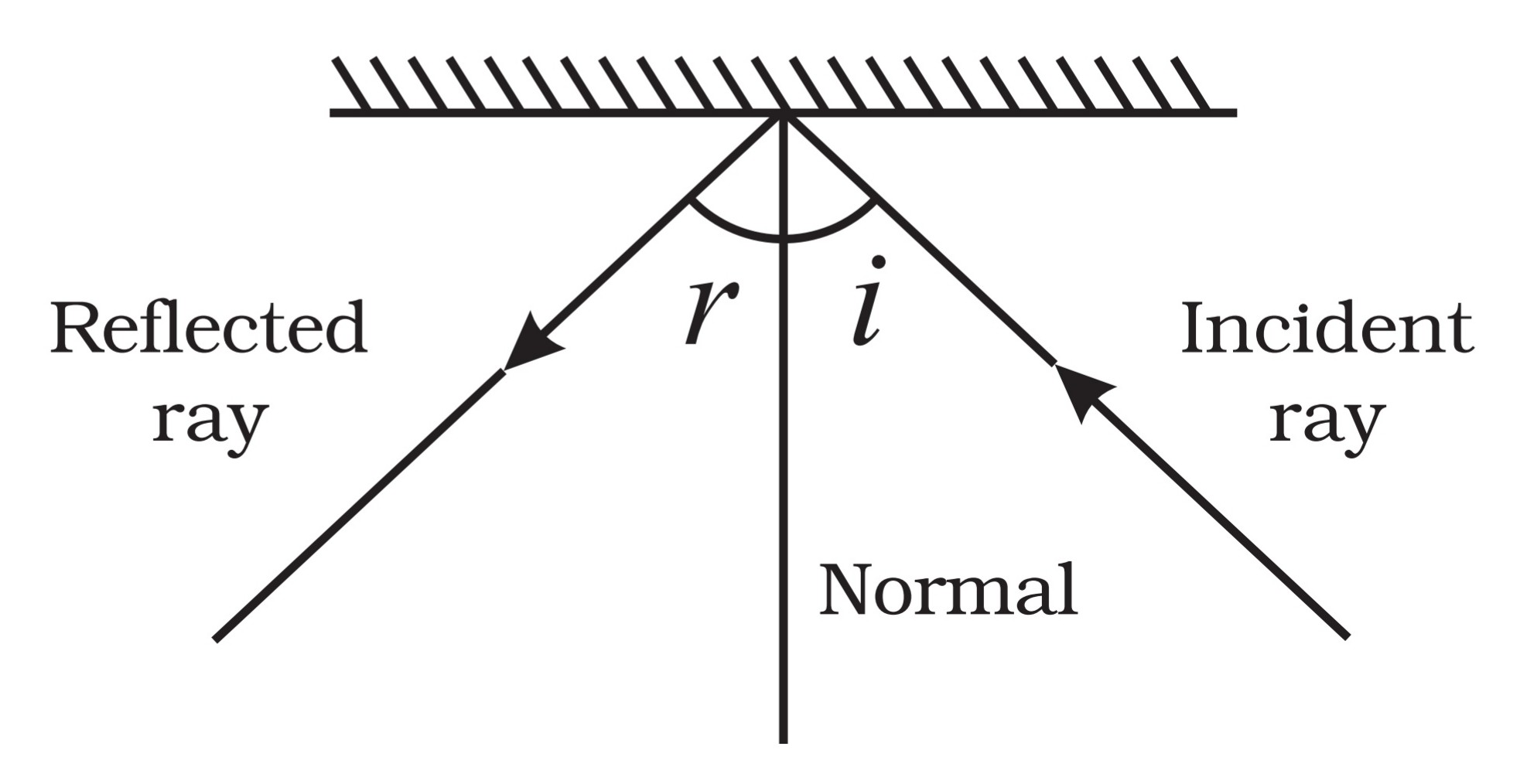
Q.5 What kind of image is formed in the mirror?
Ans – An image formed in the mirror, the left of an object becomes right and right becomes left. Such phenomenon is called lateral inversion.
Q.6 What is Diffused or irregular reflection?
Ans – When all the parallel rays reflected from the irregular shape or rough surface and then goes into multi-direction is called irregular reflection.
Q.7 What is regular reflection?
Ans – Reflection from the smooth surface like a mirror is called regular reflection.
Q.8 What is Kaleidoscope and where it is used?
Ans – Kaleidoscope reflects light again and again. Kaleidoscope is used by designers in making a new design.
Q.9 What are the major part of the human eye? ( Most Important )
Ans – There are Cornea, iris, pupil, lens, retina and optic nerves that help us to see an object. See eye diagram for more.
- Lens- The lens serves to transmit the rays falling on our eye to the retina.
- Retina- It helps us to see the size and shape of an object. When the lens focuses the rays of light and reaches the retina, the retina sends it to our brain through the nervous system.
- Ciliary muscle – It works to keep our lens balanced.
- Pupil- It controls the light entering our eye. Our pupil becomes larger in dim light and smaller in bright light. So that there is no harm to the eye.
- Iris – It gives color to eye.
- Cornea – This is the outer white part of our eye. It works to protect our eyes from the external environment. The white part of our eye is the cornea.
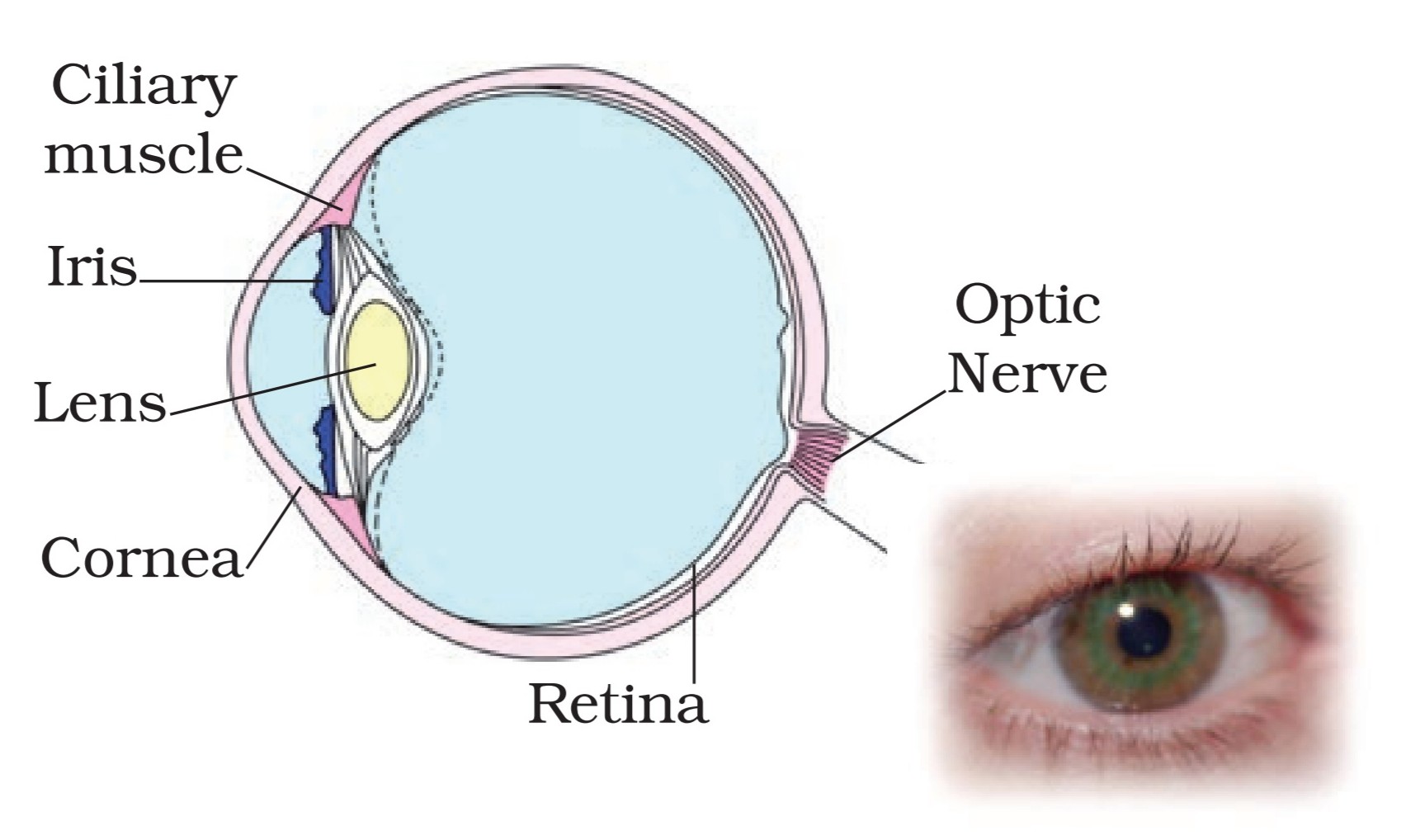
Q.10 How to take care of our eyes?
Ans – Our eye helps in observing objects. so we need to take care of our eyes. Here are the following points that keep safe our eyes.
- Use Suitable Spectacles
- Too little, Too high light is dangerous for eyes.
- Don’t look at sun or any powerful source of light directly
- Always read at a normal distance ( 25 cm ).